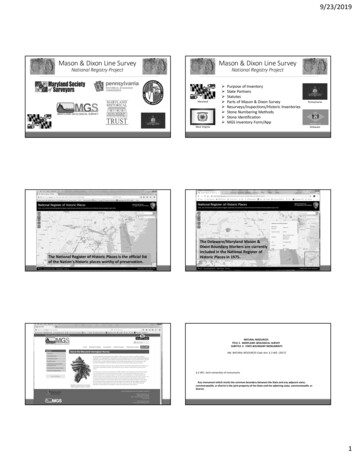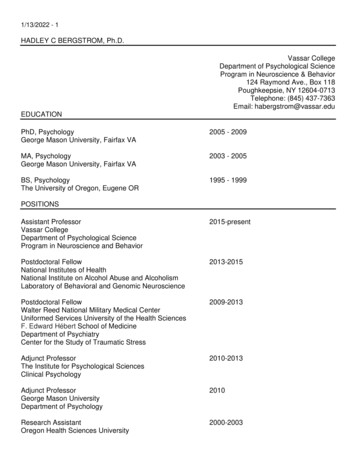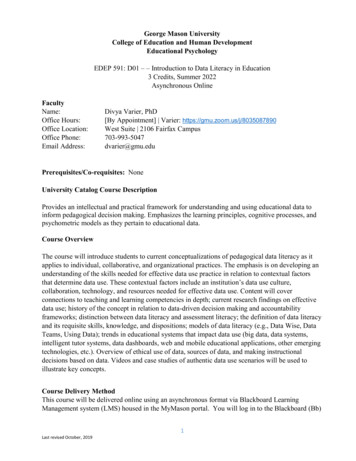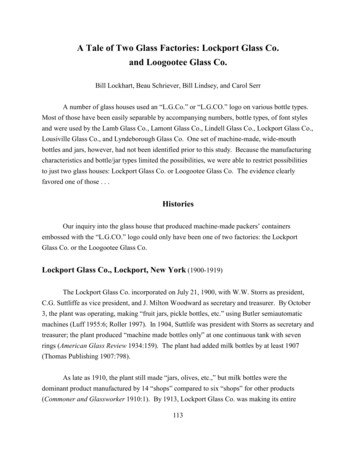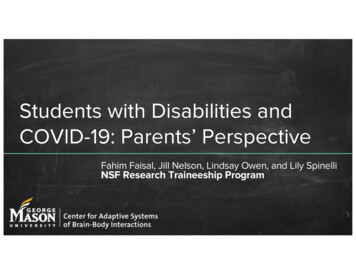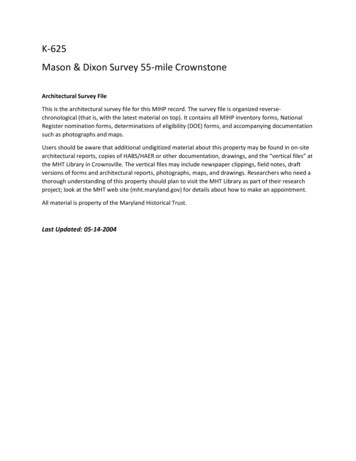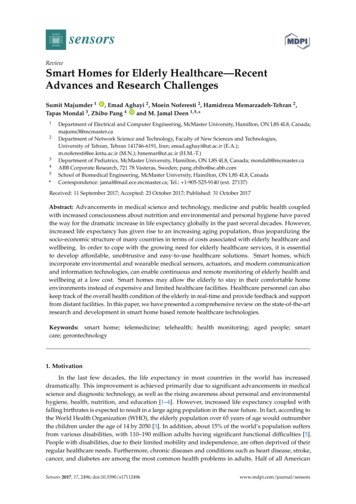
Transcription
sensorsReviewSmart Homes for Elderly Healthcare—RecentAdvances and Research ChallengesSumit Majumder 1 ID , Emad Aghayi 2 , Moein Noferesti 2 , Hamidreza Memarzadeh-Tehran 2 ,Tapas Mondal 3 , Zhibo Pang 4 ID and M. Jamal Deen 1,5, *12345*Department of Electrical and Computer Engineering, McMaster University, Hamilton, ON L8S 4L8, Canada;majums3@mcmaster.caDepartment of Network Science and Technology, Faculty of New Sciences and Technologies,University of Tehran, Tehran 141746-6191, Iran; emad.aghayi@ut.ac.ir (E.A.);m.noferesti@ee.kntu.ac.ir (M.N.); hmemar@ut.ac.ir (H.M.-T.)Department of Pediatrics, McMaster University, Hamilton, ON L8S 4L8, Canada; mondalt@mcmaster.caABB Corporate Research, 721 78 Vasteras, Sweden; pang.zhibo@se.abb.comSchool of Biomedical Engineering, McMaster University, Hamilton, ON L8S 4L8, CanadaCorrespondence: jamal@mail.ece.mcmaster.ca; Tel.: 1-905-525-9140 (ext. 27137)Received: 11 September 2017; Accepted: 23 October 2017; Published: 31 October 2017Abstract: Advancements in medical science and technology, medicine and public health coupledwith increased consciousness about nutrition and environmental and personal hygiene have pavedthe way for the dramatic increase in life expectancy globally in the past several decades. However,increased life expectancy has given rise to an increasing aging population, thus jeopardizing thesocio-economic structure of many countries in terms of costs associated with elderly healthcare andwellbeing. In order to cope with the growing need for elderly healthcare services, it is essentialto develop affordable, unobtrusive and easy-to-use healthcare solutions. Smart homes, whichincorporate environmental and wearable medical sensors, actuators, and modern communicationand information technologies, can enable continuous and remote monitoring of elderly health andwellbeing at a low cost. Smart homes may allow the elderly to stay in their comfortable homeenvironments instead of expensive and limited healthcare facilities. Healthcare personnel can alsokeep track of the overall health condition of the elderly in real-time and provide feedback and supportfrom distant facilities. In this paper, we have presented a comprehensive review on the state-of-the-artresearch and development in smart home based remote healthcare technologies.Keywords: smart home; telemedicine; telehealth; health monitoring; aged people; smartcare; gerontechnology1. MotivationIn the last few decades, the life expectancy in most countries in the world has increaseddramatically. This improvement is achieved primarily due to significant advancements in medicalscience and diagnostic technology, as well as the rising awareness about personal and environmentalhygiene, health, nutrition, and education [1–4]. However, increased life expectancy coupled withfalling birthrates is expected to result in a large aging population in the near future. In fact, according tothe World Health Organization (WHO), the elderly population over 65 years of age would outnumberthe children under the age of 14 by 2050 [3]. In addition, about 15% of the world’s population suffersfrom various disabilities, with 110–190 million adults having significant functional difficulties [5].People with disabilities, due to their limited mobility and independence, are often deprived of theirregular healthcare needs. Furthermore, chronic diseases and conditions such as heart disease, stroke,cancer, and diabetes are among the most common health problems in adults. Half of all AmericanSensors 2017, 17, 2496; doi:10.3390/s17112496www.mdpi.com/journal/sensors
Sensors 2017, 17, 24962 of 32adults aged 18 years or older are reported to have at least one chronic condition with one in threeadults suffering from multiple chronic conditions. Out of 10 leading causes of death, chronic diseasesaccount for 65–70% of total mortality [6]. In particular, heart disease and cancer together are theleading causes of death, accounting for 48% of all deaths [7]. In addition, unregulated blood sugar i.e.,diabetes, if not managed properly, may lead to long-term complications such as kidney failure, limbamputations, and blindness.Therefore, it is no wonder that the demand for healthcare services increases with the increasingaverage life expectancy of the population. However, the cost associated with present-day healthcareservices continues to rise due to the ever-rising prices of prescription drugs, diagnostic tools andin-clinic care. For example, investments in healthcare sectors increased by a massive 11.5 billion inthe 2017 budget of Ontario, Canada [8]. Therefore, existing healthcare services are likely to impose asignificant burden on the socio-economic structures of most countries, particularly the developing andleast developed ones [9–13]. In addition, a large number of elderly people require regular assistance fortheir daily living and healthcare, which are mostly supported by the family, friends or volunteers [14].Formal paid care services offered by caregivers, or elderly care centers are expensive and thus arestill out of reach for a large section of the elderly population living under constrained or fixed budgetconditions [15,16]. Therefore, there has been a growing awareness to develop and implement efficientand cost-effective strategies and systems in order to provide affordable yet superior healthcare andmonitoring services for the people having limited access to healthcare facilities, particularly theaging population.The elderly may require frequent, immediate medical intervention, which may otherwise resultinto fatal consequences. Such emergency situations can be avoided by monitoring the physiologicalparameters and activities of the elderly in a continuous fashion [16–18]. In most emergency cases, theelderly seek in-patient care, which is very expensive and can be a serious financial burden on the patientif the hospital stay is prolonged. Remote health monitoring in a smart home platform, on the other hand,allows people to remain in their comfortable home environment rather than in expensive and limitednursing homes or hospitals, ensuring maximum independence to the occupants [19]. Such smart homesare outfitted with unobtrusive and non-invasive environmental and physiological sensors and actuatorsthat can facilitate remote monitoring of the home environment (such as temperature, humidity, andsmoke in the home) as well as important physiological signs (such as heart rate, body temperature,blood pressure and blood oxygen level), and activities of the occupants. It can also communicatewith the remote healthcare facilities and caregivers, thus allowing the healthcare personnel to keeptrack of the overall physiological condition of the occupants and respond, if necessary, from a distantfacility [16,20].2. IntroductionIn recent years, the Internet-of-Things (IoT) has gained much attention from researchers,entrepreneurs, and tech giants [21–23] around the globe. The IoT is an emerging technologythat connects a variety of everyday devices and systems such as sensors, actuators, appliances,computers, and cellular phones, thus leading towards a highly distributed intelligent system capableof communicating with other devices and human beings [21–23]. The dramatic advancements incomputing and communication technologies coupled with modern low-power, low-cost sensors,actuators and electronic components have unlocked the door of ample opportunities for the IoTapplications. Smart home with integrated e-health and assisted living technology is an example ofan IoT application in gerontechnology that can potentially play a pivotal role in revolutionizing thehealthcare system for the elderly. As the world is rapidly moving towards the new era of the IoT, afully functional smart home is closer to reality than ever before.In a smart home, sensors and actuators are connected through a Personal Area Network (PAN)or Wireless Sensor Network (WSN). Wearable biomedical sensors such as electrocardiogram (ECG),electromyogram (EMG), electroencephalogram (EEG), body temperature and oxygen saturation (SpO2 )
Sensors 2017, 17, 24963 of 32sensors can be connected in a Wireless Body Area Network (WBAN) or Body Sensor Network (BSN) inorder to obtain automated, continuous, and real-time measurement of physiological signals. The centralSensors2017, 17,3 of 33BSN nodecollectsall2496physiological data, performs limited data processing and functions as thegatewayto the PAN/WSN. The actuators operate based on the feedback from the occupants or from the centralsignals. The central BSN node collects all physiological data, performs limited data processing ects environmental,physiologicalandfunctionsas thegatewaythe PAN/WSN.The actuatorsoperate based on thefeedback fromtheactivitydata throughthe PAN/WSN,and cansend Thefeedbackto theuser or systemactivatecollectsthe actuatorsoccupantsor from theanalyzescentral physiologicaland activitydatagenerator,through thePAN/WSN,them andcanfunctionssendto controlappliances suchas humidifier,oxygenovenand airanalyzesconditioner.It trolappliancessuchashumidifier,oxygenthe central home gateway, which sends measured data to the healthcare personnel/service providersgenerator, oven and air conditioner. It also functions as the central home gateway, which sendsover the internet or the cellular network. In order to realize communication between all wirelessmeasured data to the healthcare personnel/service providers over the internet or the cellularsensors andactuators,standardprotocolsfrom WirelessNetworksand ad-hocnetworksnetwork.In orderto realizecommunicationbetween Sensorall wirelesssensors(WSNs)and actuators,standardare used.protocolsHowever,designedfor WSNsare notalwaysto WBANfromcurrentWirelessprotocolsSensor Networks(WSNs)and ad-hocnetworksareapplicableused. However,current[24–26].An illustrationof adesignedmedicalforWBANfor patientshown[24–26].in FigureMultiple sensorscanprotocolsWSNsusedare notalways monitoringapplicable toisWBANAn1.illustrationof amedicalWBAN orusedfor patientmonitoringshown in Figure1. Multiplesensorscan bemeasurementplacedbe placedover clothesdirectlyon thebody, orisimplantedin tissue,which canfacilitateclothesheartor directlyon the glucose,body, or implantedtissue,which canratefacilitateofof bloodoverpressure,rate, bloodEEG, ECGinandrespiration[27]. measurementSome applicationsofblood pressure, heart rate, blood glucose, EEG, ECG and respiration rate [27]. Some applications ofWBAN from the literature, which are important for smart home, are presented in Table 1.WBAN from the literature, which are important for smart home, are presented in Table 1.Figure 1. Wireless Body Area Network (WBAN) for wearable medical sensors.Figure 1. Wireless Body Area Network (WBAN) for wearable medical sensors.The market penetration of smart home has seen a steady rise over the past few years. Thethe global smarthomeshomemarketin 2014at 20.38is projectedto growTherevenuemarketofpenetrationof smarthasseenwasa steadyrisebillionoverandthe itpastfew years.Thetorevenue arketiscurrentlyinastateofstagnationof the global smart homes market in 2014 was at 20.38 billion and it is projected to grow to 58.68primarily due to the high price of components, limited demands, long replacement periods as wellbillion by 2020 [28]. Unfortunately, the smart home market is currently in a state of stagnation primarilyas consumers’ reluctance to adopt currently available complex systems, which require multipledue to thehigh priceof components,demands,long replacementwell asconsumers’networkingdevicesand softwarelimitedapplicationsto implementand control periodsthe ddition, ensuring the privacy and security of the sensitive medical and personal information isdevicescritical applicationsfor achieving widespreadacceptance[19].However,continuousand softwareto implementand amongcontrolconsumersthe smarthomes[29].withIn theaddition,ensuringadvancementof high-speedcomputingand securedcommunicationtechnologiescoupledthe privacyand securityof the sensitivemedicaland personalinformationis criticalforwithachievingminiaturized low-power and low-cost sensors and actuators, it is expected that the smart homewidespreadacceptance among consumers [19]. However, with the continuous advancement ofmarket will flourish dramatically in the coming years, thus leading towards ‘smart cities’ [30].high-speed computingand secured communication technologies coupled with miniaturized low-powerIn this article, we present a review on the current state of research and development in smartand low-costsensorsandactuators,is expectedthatthe smartwillflourishdramaticallyhomes with a primaryfocus on itremotehealthcareservices.The homeconceptmarketof remotehealthmonitoringin the comingyears,thus leadingtowards‘smart[30]. (Section 4) on the architecture andis studiedin Section3, whichis followedby cities’a discussionstandardsof anhome onfor remotehealth statemonitoring.Some recenton differentIn thisarticle,weIoT-basedpresentsmarta reviewthe currentof researchand worksdevelopmentin smartformsof remote focushealthcareserviceshealthcareare presentedin SectionIn Sectionwe presentsomekeyhomes witha primaryon remoteservices.The5.conceptof 6,remotehealthmonitoringisprototypes and commercially available solutions of smart homes. Some key challenges in realizingstudied in Section 3, which is followed by a discussion (Section 4) on the architecture and standardsof an IoT-based smart home for remote health monitoring. Some recent works on different forms ofremote healthcare services are presented in Section 5. In Section 6, we present some key prototypes and
Sensors 2017, 17, 24964 of 32commercially available solutions of smart homes. Some key challenges in realizing fully functionalsmart homes are discussed in Section 7. Finally, the paper is concluded in Section 8 with some futureperspectives of smart homes.Table 1. Some examples of WBAN applications in the literature.1.Wearable WBAN2.3.Monitoring activities of soldiers in the battlefieldby WBAN by using sensors, cameras and wirelesstechnologies [31].Monitoring harsh environments by policemen andfire-fighters in order to reduce the casualties [32].Real-time health monitoring. For instance, the cellphone of a diabetic patient can detect the glucoseand send it to a doctor for analysis [33].WBAN Applications1.Myocardial Infarction (MI) can be reduced bymonitoring episodic events and other abnormalconditions through WBAN technologies [34].1.WBAN can be connected with a medical carefacility over the internet in order to monitor healthconditions, thus reducing the dependency ofpatients on in-clinic monitoring [35].Integrating WBANs in a telemedicine systems topromote ambulatory health monitoring [36].Implantable WBANRemote HealthMonitoring2.3. Remote Health MonitoringModern sedentary lifestyles and food habits coupled with large aging population have resultedin a rising tide of chronic diseases such as heart disease, obesity, diabetes and asthma [19]. Accordingto the World Health organization (WHO), cardiovascular diseases are currently responsible for mostdeaths around the globe [37]. In addition, diabetes is rising dramatically and expected to be the seventhleading cause of death in 2030 [38]. Furthermore, poor outdoor air quality in most industrial and bigcities is giving rise to cancer, cardiovascular and respiratory diseases such as asthma, and lung diseases.Around 235 million people are currently suffering from asthma and an estimated 383,000 people diedfrom asthma in 2015 [39]. Although, chronic diseases are among the most common and costly healthissues, they can be prevented by early detection through long-term monitoring or controlled effectivelythrough appropriate management, thus allowing people to enjoy a good quality of life [40]. However,shortage of skilled healthcare personnel, limited budget, increasing healthcare cost coupled withgrowing healthcare needs [41] are the critical constraints for long-term monitoring and managementof health. Therefore, an affordable, un-obtrusive and comprehensive healthcare solution with minimalworkforce is of utmost importance for long-term health management and monitoring, especially forthe rapidly rising elderly population.3.1. E-Health and M-HealthE-health utilizes information and communication technologies to digitize and automate healthcareprocesses and tasks, thus enabling services like e-prescription, e-supply and e-records [42] for patients.For example, electronic medical records (EMRs) or electronic health records (EHRs) can store andprovide complete and detailed information about the medical history of patients, which can beaccessed remotely and used by the authorized healthcare personnel for decision-making [43–45].Modern information and communication technologies allow continuous monitoring and recording ofphysiological parameters/signals, which can be stored in a central secured database. These recordscan be made readily available to the authorized personnel such as caregivers, emergency medicalservices (EMS) and family doctors when needed. A fully functional E-health system may lead towardsan efficient, high quality and ubiquitous healthcare service at a lower cost and with minimal error. Theinfrastructure of E-health is illustrated in Figure 2.
Sensors 2017, 17, 24965 of 32Sensors 2017, 17, 24965 of 33Figure 2. E-Health Infrastructure.Figure 2. E-Health Infrastructure.However, the advancement of compact, portable communication and computing devices suchas smartphones,and tabletsofhascreated thepathwaysfor the evolutionM-health fromthe such asHowever,the advancementcompact,portablecommunicationand ofcomputingdevicesclassical E-health concept. M-health is based-on modern mobile communication technologies such assmartphones, and tablets has created the pathways for the evolution of M-health from the classicalEnhanced Data GSM Environment (EDGE), 3G, High Speed Packet Access (HSPA), and Long-TermE-health concept. M-health is based-on modern mobile communication technologies such as EnhancedEvolution (LTE), which offer high-speed and seamless data transfer from anywhere, at any time,Data GSMHigh withSpeedAccess (HSPA),thusEnvironmentallowing people(EDGE),to remain3G,connectedthePacketcentral M-healthsystem. and Long-Term Evolution(LTE), whichhigh-speedseamlessdata transferfrom anywhere,at anytime,thuscanallowingAsoffermentionedearlier, anda networkof environmental,biomedical,and motionsensors,whichmeasureandsend measuredto the remotefacilitiesthrough the gateway, can be deployed atpeople toremainconnectedwith datathe ocatedin (implantedbiomedical,devices, e.g., ,a networkenvironmental,and motionsensors,which canon (e.g., ECG or EEG electrodes), or around (e.g., gesture detectors, external devices) the humanmeasure and send measured data to the remote facilities through the gateway, can be deployed atbody can be connected in a BAN, thereby enabling ubiquitous, un-obtrusive continuous healthhome. Wearablebiomedical sensors located in (implanted devices, e.g., pacemaker, insulin injector),monitoring. The data collected by the sensors are transmitted to a central BAN node, which canon (e.g.,processECG orandEEGelectrodes),or aroundgesturedevices)human bodytransferinformationto an (e.g.,externaldevicedetectors,(the user’sexternalmobile phone)or thea remotecan be nitoring.workstationin(a anursestationin a enablinghospital orubiquitous,nursing home).Monitoring ofkey parameterssuchasactivity,heartrate (HR),blood pressurerespirationrate (RR)and canbodyprocesstemperatureThe datapatient’scollectedby thesensorsare transmittedto a(BP),centralBAN node,whichand transfer(BT) fromremote devicestation (theand sendingfeedbackaccordinglyover theM-health systemmayinformationto an aexternaluser’s mobilephone)or a remoteworkstation(a nursestation inpotentially lead towards the E-ambulatory care system [46].a hospital or nursing home). Monitoring of key parameters such as patient’s activity, heart rate (HR),It is expected that modern miniature sensing and actuating technologies along with theblood pressurerespirationrate (RR)andasbody(BT) fromand mperatureand home basedWSNa remoteas well stationas increasedfeedbackaccordinglyover the M-healthsystem maypotentiallyleadthe E-ambulatorycarepenetrationof high-speedinternet globallywill playa pivotalroletowardsin movingtowards theremote healthcare services from the conventional in-clinic care. The network of sensorssystem home-based[46].thethatconditionof miniaturethe subject sensingunder supervisionand sendsthe informationto a distantIt ismonitorsexpectedmodernand actuatingtechnologiesalong withthe advancedhealthcare facility over the internet [47] or it can automatically call for EMS in case of an emergency.connectivity platforms such as BAN and home based WSN as well as increased penetration ofHowever, ensuring seamless connectivity, secured transmission channels and data storage are thehigh-speedinternet globally will play a pivotal role in moving towards the home-based remotekey challenges in developing a complete infrastructure of an E-health or M-health system forhealthcareservicesfrom theconventionalcare.The networkof Moreover,sensors monitorsthe conditionmedicalinformationmanagementand in-cliniccontinuousmonitoringof health.interoperabilityof the subjectunder supervisionsendsis theto a distanthealthcarefacilityInover theamong differentprotocols andandstandardsalso informationcritical for the consistentoperationof the system.and accurate measurementshealthparametersare vitalfor a reliablehealthinternetaddition,[47] or itprecisecan automaticallycall for EMSofinkeycaseof em.connectivity, secured transmission channels and data storage are the key challenges in developinga completeinfrastructure of an E-health or M-health system for medical information management3.2. Home-Based Remote Health Monitoringand continuous monitoring of health. Moreover, interoperability among different protocols andThe advancement of miniaturized and inexpensive sensors, embedded computing devices, andstandards is also critical for the consistent operation of the system. In addition, precise and accuratewireless networking technologies paved the way for realizing remote health monitoring systems.measurementskey healthparametersvital for a ubiquitous,reliable healthsystem. ofRemote ofhealthmonitoringallows areun-obtrusive,and monitoringreal-time monitoringphysiological signs without interrupting the daily activities of individuals. People can remain in3.2. Home-BasedRemoteMonitoringtheir familiarhomeHealthenvironmentand enjoy their normal lives with the friends and family while theiris being monitored and analyzed from a remote facility based-on the physiological dataThehealthadvancementof miniaturized and inexpensive sensors, embedded computing devices, andcollected by different on-body sensors. The system can perform long-term health trend analysis,wirelessdetectnetworkingtechnologiespaved the way for realizing remote health monitoring systems.anomalies, and generate alert signals in the case of an emergency.Remote health monitoring allows un-obtrusive, ubiquitous, and real-time monitoring of physiologicalsigns without interrupting the daily activities of individuals. People can remain in their familiar homeenvironment and enjoy their normal lives with the friends and family while their health is beingmonitored and analyzed from a remote facility based-on the physiological data collected by differenton-body sensors. The system can perform long-term health trend analysis, detect anomalies, andgenerate alert signals in the case of an emergency.
Sensors 2017, 17, 24966 of 32In order to facilitate continuous monitoring of health, various E-health devices are proposed inthe literature [48,49]. EnViBo, which stands for embedded network for vital sign and biomedicalsignal monitoring, is such a platform for the ambulatory monitoring of adults with medicalconditions or people working under extreme conditions such as firefighters and rescue personnel [50].An open-source platform for a wireless body sensor network named DexterNet was presented in [49].This platform comprises a body sensor layer (BSL), a personal network layer (PNL), and a globalnetwork layer (GNL) that supports real-time and persistent human monitoring in both indoor andoutdoor environments [49].Telemedicine is an advanced form of E-health service which provides remote healthcare support,analyzes the trends in medicine usage and makes the information available to the authorized personnelwith the help of modern communication technologies, thus allowing faster and affordable healthcareservices [51]. In a recent study [52] on the effectiveness of telemedicine, it was found that telemedicinewas beneficial to reduce mortality due to different causes. Telemedicine also effectively reduceshospital admission, length of stay and mortality due to heart failure [52]. A telemedicine system forin-home monitoring of vital signs is presented in [36]. The sensors communicate with an android basedsmartphone using Bluetooth. The smartphone functions as the gateway to a long range communicationnetwork such as a 3G cellular phone network or wireless local area network (WLAN). A tele-medicinesystem that can measure several physiological signs of the resident and send them to a computingplatform for further analysis was developed and reported in [53]. The medical staffs can keep track ofthe signs over a web-based interface. The system is capable of transmitting real-time information toa remote medical server over both the cellular networks and internet in case of an emergency or onrequest. Some technology companies are currently offering tele-medicine services over web-basedplatform [54–57]. The services include secure video communication between doctor and patients,remote health monitoring, and emergency care service.Intelligent furniture such as smart chairs and smart beds can also be utilized for measuringphysiological data at home. For example, a smart bed can monitor the health status and sleep patternsof an individual. It can also be used to detect a heart attack of the cardiac patients while they are onthe bed or sleeping. The system can immediately inform the central system, caregivers, EMS or anyauthorized personnel in an automatic fashion, thus reducing the risk of fatality.4. Internet-of-Things and Connected HomesThe developments of low-power wireless communication technologies, miniaturized sensorsand actuators as well as growing penetration of internet, tablets, and smartphones are leading ustowards the new era of the IoT [21]. Connected homes or smart homes use the concept of the IoT,which offers a platform to monitor safety and security of the home or to automatically control thehome environment or appliances, over the internet from anywhere. The IoT can be defined as anetwork of intelligent objects that is capable of organizing and sharing information, data and resources,decision making, and responding to feedback [58]. It allows human-to-human, human-to-things andthings-to-things interaction by providing a unique identity to each and every object [59]. The USNational Intelligence Council (NIC) considered the IoT technology as one of the six disruptive civiltechnologies that can potentially impact US national power [60]. Some researchers envisioned theIoT as an emerging field that can enable new ways of living by bridging the physical world withthe digital computing platform by means of smart sensing and actuating devices, and appropriatecommunication technologies such as Bluetooth Low Energy (BLE), ZigBee and ANT [61–64]. Therefore,the concept of IoT can be exploited in a wide range of applications (Figure 3) such as E-health, assistedliving, enhanced learning, intelligent transportation, environmental protection, government work,public security, smart homes, intelligent fire control, industrial monitoring and automation [65].Traditional homes, in spite of being energy-hungry, are generally not designed to monitor theenvironment of the home, or physiological conditions and activities of the occupants by itself [63].A smart home, in contrast, is a traditional house embedded with smart devices and modern
Sensors 2017, 17, 24967 of 32Sensors 2017,technologies17, 24967 of 33communicationthat can facilitate remote and automatic monitoring of home environment,security and overall health status of the occupants. However, in order to achieve widespreadcommunication technologies that can facilitate remote and automatic monitoring of homeacceptanceamongefficientSensors2017, 17,the2496 users, smart homes need to be affordable. Therefore, low-power and7 of 33environment,security and overall health status of the occupants. However, in order to alongwithlow-costdevicesarecriticalforwidespread acceptance among the users, smart homes need to be affordable. Therefore, low-power smartcommunication technologies that can facilitate remote and automatic monitoring of homehomes. andIn addition,several key technologiestechnologicalsuch alongas fullinteroperabilitytheefficient communicationandchallengespublic networks,withlow-cost devicesamongareenvironment, security and overall health status of the occupants. However, in order to ices, high degree of precision and accuracy,
sensors Review Smart Homes for Elderly Healthcare—Recent Advances and Research Challenges Sumit Majumder 1 ID, Emad Aghayi 2, Moein Noferesti 2, Hamidreza Memarzadeh-Tehran 2, Tapas Mondal 3, Zhibo Pang 4 ID and M. Jamal Deen 1,5,* 1 Department of Electrical and Computer Engineering, McMaster University, Hamilton, ON L8S 4L8, Canada; majums3@mcmaster.ca 2 Department of Network Science and .
